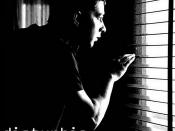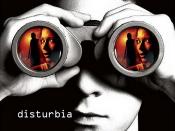Oh the joys of voyeurism. Many people take pleasure in the position of watching others live their lives, as is the case with reality television. Kale Brecht is no exception to this infatuation by society, since he too gazes upon neighbours through his bedroom windows using various technologies. Whether it is admiring a crush from afar or trying to investigate a potential crime scene, Kale becomes a spy in his neighbourhood. This concept of watching others secretively is the dominant theme in Disturbia, as it points out potential flaws in society. Encouraging isolation, complicating binary oppositions, and threatening peopleÃÂs privacy are all negative results of spying. D.J. CarusoÃÂs Disturbia is a statement of the complications that arise from societyÃÂs growing obsession with voyeurism.
Firstly, voyeurism encourages isolation in society as shown in Disturbia. It is known in society that isolation is a common occurrence in suburban areas. In the film, Kale gets bored at home and ÃÂturns to watching his neighbours for entertainment and finds trivial amusements in their everyday lives.ÃÂ
(Gearing). Since he is already under house arrest and secluded, he continues to put himself further into isolation by being a voyeur. He watches his neighbours and chooses to never come into contact them until they confront him about his mischievous ways. This is echoed in society as voyeurs take satisfaction and pleasure from watching others, which at times consumes their lives leading them to be inactive in the social world. Kale goes back to spying on Ashley and Robert to satisfy his curiosity and it basically overtakes his life, leaving no room for communication with others outside of his mother and best friend. He drifts away from the real world and enters his own private imagination. This encouragement of isolation through spying does no way in benefiting civic engagement, therefore it complicates society.
Secondly, in Disturbia, there is a complication of societyÃÂs binary oppositions as a result of voyeurism. A conflict of whether something is good or bad arises from the movie, as does the blurring of the line between reality and imagination. First of all, the concept of spying could be for good or it could be for bad, but where exactly is the line drawn? Kale uses voyeurism for good in that he investigates the suspicious serial killer Robert Turner, but at the same time, spying is not a socially accepted hobby in the first place. He uses the voyeurism in a more obvious improper situation. Kale secretively ogles a new neighbour, Ashley, and follows her every move from his own home. When applying this to society, security cameras are obviously used for good, but at the same time, these cameras could be used for other violations against citizens. In regards to reality versus entertainment, Ryan Cracknell states that ÃÂCaruso does a good job building up KaleÃÂs boredom early on, allowing the potentially preposterousness that ensues to at least have a foothold in the realm of both reality and fantasy.ÃÂ (Cracknell). In the film, when Kale first stumbles upon the potential murderer Turner, it is unclear whether this is really the truth or whether his boredom had affected his mental state. He was stubborn and jumped to conclusions about the situation. Even though Kale was right in his inference, society is not so heroic in every decision. We make many decisions where our judgements of what we think we see are thought up instead what had really occurred. This complicates society because it makes everyone question the truth and important establishments like the judicial system are also questioned. Complications between binary oppositions caused by voyeurism in Disturbia reflect the real worldÃÂs conflictions.
Lastly, voyeurism in Disturbia threatens societyÃÂs impression of privacy. ÃÂÃÂ with todayÃÂs high level of technology including the Internet, web cams, and home video cameras, the sense of voyeurism and paranoia is at an all time high; are you watching someone or is someone watching you?ÃÂ (Cummings). Kale, a supposed typical suburban teenager, uses technology to such a high degree for spying on his neighbours in order to be ÃÂproductiveÃÂ in his months of house arrest: ÃÂWhatÃÂs a bored teenager to do? Using some second hand surveillance equipment, he begins spyingÃÂ ÃÂ (Levy). Kale and his friends utilize cell phones and video cameras to essentially stalk and intrude on TurnerÃÂs life. They even go so far as to break into his car to steal the code to his garage door opener in order to continue their investigation inside his house. This goes to show that technology takes voyeurism to a whole new level; once the voyeur gets a small piece of what they want, they want to dig deeper and deeper to satisfy their curiosity, which is a major crisis in terms of our privacy. Also, the internet has had such an influence on society that any user could be monitored at any time. Technology has made it so easy for people to threaten peopleÃÂs privacy through spying as shown in Disturbia.
In conclusion, Disturbia is a statement on societyÃÂs ways. ÃÂAs a film, ÃÂDisturbiaÃÂ is much more concerned about entertainment value than cultural commentary.ÃÂ (Lewis). This is partially true, but itÃÂs implications on voyeurism and society are very significant. Voyeurism in Disturbia suggests to society that it encourages isolation, it complicates binary oppositions, and it threatens our privacy and security. All in all, Disturbia does an excellent job in informing society about the various dangers and complications voyeurism creates.
BibliographyCracknell, Ryan. ÃÂDisturbia.ÃÂ Moviews. 2007. October 3, 2007. Cummings, Daniel. ÃÂMovie Review: Disturbia.ÃÂ Blog Critics Magazine. 2007. October 3,2007. Gearing, Chris. ÃÂLIFE: ÃÂDisturbiaÃÂ ruins the neighbourhood.ÃÂ Inside Vandy. 2007.October 3, 2007. Levy, Emanuel. ÃÂDisturbia.ÃÂ Emanuel Levy. 2007. October 3, 2007. Lewis, Richard. ÃÂDisturbia (2007) Movie Review / Shia LaBeouf Takes us on a Trip toDisturbia.ÃÂ Beyond Hollywood. 2007. October 3, 2007.





